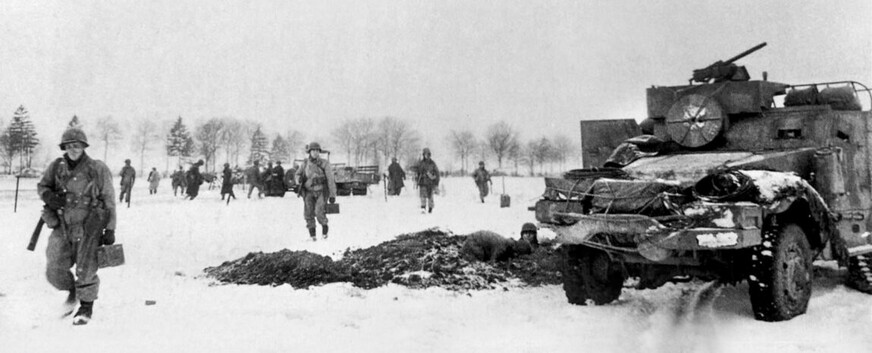Eighty years ago, this month, most American and British troops were fighting a stubborn German retreat in the Ardennes and Hurtgen forests of Luxembourg and Belgium. Their commanders, despite the heavy fighting, felt that victory was close.
Hitler, on the other hand, had other plans for the allies and the plans were set in motion in the early hours of December 12th, 1944. Over 250,000 German troops (30 divisions) broke through a weak point in the American lines along the Ardennes, eerily similar to earlier Nazi blitzkrieg operations. So began the famous Battle of the Bulge.
The German objectives were bold and risky. They wished to drive all the way to Antwerp and cut off supplies from its port to the combined allied armies, while separating them from each other. Since they were short of fuel, seizing allied supply depots along the way was essential to maintain the attack.
Allied air power was overwhelming by late 1944 so the Germans planned the attack to start during forecasted poor weather. Indeed, for a week, there was unending mist and rain. Allied air power was grounded.
 The name “Battle of the Bulge” relates to the incursion and subsequent bulging of the American lines. Although the lines stretched, they did not break. The success of the American army in ultimately stopping the German advance was owed to numerous actions but none as famous as Bastogne.
The name “Battle of the Bulge” relates to the incursion and subsequent bulging of the American lines. Although the lines stretched, they did not break. The success of the American army in ultimately stopping the German advance was owed to numerous actions but none as famous as Bastogne.
Taking Bastogne was key for German army plans. All roads from the Ardennes ran through Bastogne making its seizure critical. The importance of Bastogne was not lost on the American army and the 101st Airborne Division was assigned its defense. By December 20th, the Germans had surrounded the city with over 54,000 troops.
Three days into the siege of Bastogne, an unauthorized German delegation demanded the surrender of the city. The reply from 101st commander, General Anthony McAuliffe, is legendary: “Nuts!”

On December 19th General George Patton’s Third Army began preparations for a 90 degree left turn towards Bastogne. The march began on the morning of December 22nd and culminated in the relief of Bastogne on December 26th. Patton’s pivot and rapid advance to relieve the 101st is the stuff of military legend.
 Patton’s relief coincided with a clearing of the weather and a resumption of allied air operations. Territory lost to the German offensive was quickly retaken and the battle was deemed over on January 28th.
Patton’s relief coincided with a clearing of the weather and a resumption of allied air operations. Territory lost to the German offensive was quickly retaken and the battle was deemed over on January 28th.
For American GI’s it was often difficult to determine what was worse: the Germans or the weather. The winter of 1944-45 was one of the coldest on record. For a solid month the weather alternated between snow, ice and freezing rain. Frostbite, trench foot and inadequate winter clothing were constant threats.
The Battle of the Bulge is the largest battle in US Army history. At the battle’s peak, over 600,000 GI’s were brought to bear against the German offensive. It was a meat grinder with both armies taking casualties between 70-80,000 men each.
When the battle was over the world witnessed once again: The USA may bend but it never breaks.
COS supporters believe that we must never forget our true heritage and accomplishments. We celebrate our history from the Revolution, Constitution, and many wars through all the amendments, good and bad, right up to the present battles for a return to Constitutional integrity. Join us in our efforts to re-establish state sovereignty.






